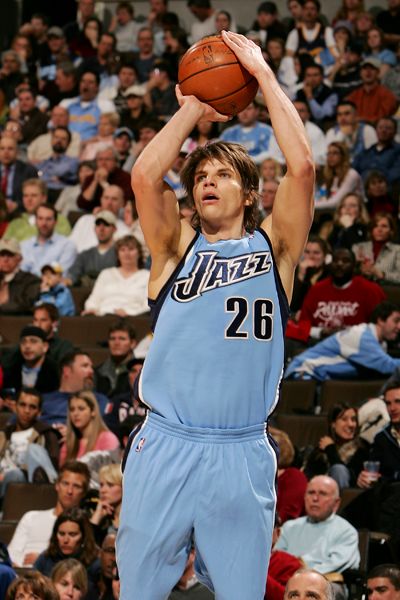Although the 2013 NBA free agent class is generally weak outside of Chris Paul and Dwight Howard, there are still several role players who could be valuable additions for teams such as the Jazz (who have between $25-30 million in cap room).
One of the first free agents to make news thus far has been Kyle Korver – who reportedly is very close to agreeing to sign with the Brooklyn Nets. Korver played in Utah from 2008-10 and in 2009-10 set the NBA single-season record for three-point FG percentage shooting 53.6% behind the arc.
Kyle Korver 2009-10 Shot Chart

One of the most interesting aspects of Korver’s 2009-10 shot chart is the volume and accuracy he displayed on his corner threes, which is indicative of his entire career in Utah in which he shot a higher percentage on corner-threes than from other locations behind the arc.
| Korver | Overall | Corner Threes | Other Threes | ||||||
| Season | 3pt | Att | 3pt% | 3pt | Att | 3pt% | 3pt | Att | 3pt% |
| 2007-08 | 111 | 296 | 37.5% | 43 | 96 | 44.8% | 68 | 200 | 34.0% |
| 2008-09 | 103 | 267 | 38.6% | 54 | 138 | 39.1% | 49 | 129 | 38.0% |
| 2009-10 | 59 | 110 | 53.6% | 33 | 61 | 54.1% | 26 | 49 | 53.1% |
These percentages also reflect those of the league’s two premier teams – as both the Miami Heat and the San Antonio Spurs shoot significantly higher percentages on corner threes than non-corner threes.
| 2012-13 | 3pt FG Percentage | |
| Team | Corner 3pt% | Other 3pt% |
| Heat | 43.0% | 37.6% |
| Spurs | 41.1% | 36.0% |
Those discrepancies in corner and non-corner 3pt-percentages weren’t evident in Utah’s 2012-13 season.
| 2012-13 | Overall | Corner Threes | Non-Corner Threes | ||||||
| Season | 3pt | Att | 3pt% | 3pt | Att | 3pt% | 3pt | Att | 3pt% |
| Jazz | 507 | 1385 | 36.6% | 119 | 315 | 37.8% | 388 | 1052 | 36.9% |
A shift in Utah’s offensive philosophy from the past few seasons could re-open opportunities to shoot the corner three with greater efficiency. When Al Jefferson was iso’d on the left block, the left corner of the floor was cleared out and the chances of Jefferson recognizing a double-team and kicking it out quickly enough for Utah’s perimeter players to swing the ball around the horn for a corner three were minimal. Conversely, running high screen-roll where you have shooters camped in either corner who can roll up on the weakside (a la Hornacek/Memo) or drift to the corner on the strong side (a la Russell/Korver) creates much cleaner looks from behind the arc.
With the draft night acquisition of Trey Burke (a true screen-roll point guard who can penetrate and kickout) figures to create a plethora of open shots for a perimeter shooter who can drift around the three-point line – similar to how Korver played off Deron Williams in Utah.
Perhaps the best example of the floor-spacing Korver provided Deron and the Jazz was in Game 2 of the first-round of the 2010 playoffs. With 90-seconds left and the Utah trailing Denver 106-105, Korver put the Jazz ahead for good with a clutch three (6:37-mark).

1. With the shot clock winding down, Utah runs high screen roll between Deron Williams and Paul Millsap. Simultaneously, Kyle Korver (guarded by J.R. Smith) drifts out to the three-point line to create a lane for Millsap to “roll.”

2. Korver’s drift behind the 3pt-line provides Utah with their necessary floor-spacing. J.R. Smith is forced to cut off the lane as Millsap rolls to the basket, giving Deron the read to find Korver wide-open on the perimeter.

3. Smith can’t recover in time to prevent Korver from getting a clean look at the basket to put Utah ahead for good. Two possessions later Korver preserves Utah’s lead when he draws a charge on Chauncey Billups in the paint. Utah stole Denver’s homecourt advantage which proved to be the difference in their 4-2 series victory.
_________________________________________
The NBA has become a screen-roll league, and Trey Burke was the best pick&roll guard in the draft. Not only does Burke provide Utah with a presence at point guard, his skillset offers the Jazz a set of guidelines to follow when filling in the pieces around their core players. It’s incredibly difficult to identify a quality SG to play next to a low-efficiency, shoot-first and ask questions later PG like Mo Williams. On the other hand, it’s amazing how much more appealing role-players become when you have a point guard who can penetrate and create better looks for his teammates.
Korver was one of those valuable complementary pieces for Utah in 2008, and he could have been one again in 2013. Regardless of how long Korver remains on the open market, the Jazz would be wise to target “value role players” in his mold whose presence provides floor-spacing but doesn’t demand minutes (such as a Carlos Delfino or Marco Belinelli), rather than bigger name perimeter players who would have trouble fitting in and demand larger roles such as Tyreke Evans and O.J. Mayo.








